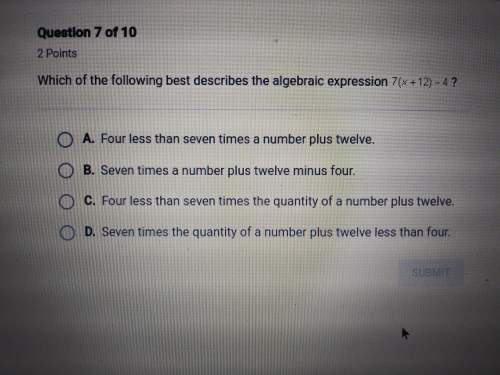
Mathematics, 11.05.2021 17:50 jennybee12331
Two recreational volleyball teams, Cherryville and Mount Irving, wanted to compare the ages of their players.
The ages of the Cherryville players are 16, 16, 17, 17, 17, 18, and 18. The mean age of the Cherryville players is 17.
The ages of the Mount Irving players are 16, 17, 18, 18, 19, 19, and 19. The mean age of the Mount Irving players is 18.
Which statement is true?
Team Cherryville's players ages vary more than Team Mount Irving's players ages.
The range of Cherryville's players ages is greater than the range of Mount Irving's player's ages.
Team Mount Irving's player's ages vary the same amount as Team Cherryville's player's ages.
Team Mount Irving's player's ages vary more than team Cherryville's Players' ages.

Answers: 1


Another question on Mathematics

Mathematics, 21.06.2019 16:50
If the table of the function contains exactly two potential turning points, one with an input value of –1, which statement best describes all possible values of m? m ≥ –12 –12 < m < 4 m ≤ 4 m ≥ 4 or m ≤ –12
Answers: 1

Mathematics, 21.06.2019 20:50
An automobile assembly line operation has a scheduled mean completion time, μ, of 12 minutes. the standard deviation of completion times is 1.6 minutes. it is claimed that, under new management, the mean completion time has decreased. to test this claim, a random sample of 33 completion times under new management was taken. the sample had a mean of 11.2 minutes. assume that the population is normally distributed. can we support, at the 0.05 level of significance, the claim that the mean completion time has decreased under new management? assume that the standard deviation of completion times has not changed.
Answers: 3

Mathematics, 21.06.2019 21:40
Write the contrapositive of the conditional statement. determine whether the contrapositive is true or false. if it is false, find a counterexample. a converse statement is formed by exchanging the hypothesis and conclusion of the conditional. a) a non-converse statement is not formed by exchanging the hypothesis and conclusion of the conditional. true b) a statement not formed by exchanging the hypothesis and conclusion of the conditional is a converse statement. false; an inverse statement is not formed by exchanging the hypothesis and conclusion of the conditional. c) a non-converse statement is formed by exchanging the hypothesis and conclusion of the conditional. false; an inverse statement is formed by negating both the hypothesis and conclusion of the conditional. d) a statement not formed by exchanging the hypothesis and conclusion of the conditional is not a converse statement. true
Answers: 1

Mathematics, 22.06.2019 01:00
Find the average rate of change for the given function drom x=1 to x=2
Answers: 1
You know the right answer?
Two recreational volleyball teams, Cherryville and Mount Irving, wanted to compare the ages of their...
Questions


Mathematics, 19.08.2019 11:10


History, 19.08.2019 11:10




Mathematics, 19.08.2019 11:10

Computers and Technology, 19.08.2019 11:10




Physics, 19.08.2019 11:10

Mathematics, 19.08.2019 11:10


Social Studies, 19.08.2019 11:20


History, 19.08.2019 11:20





